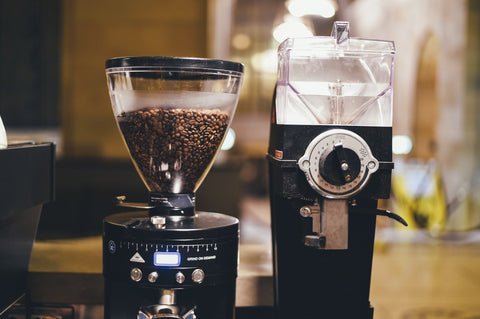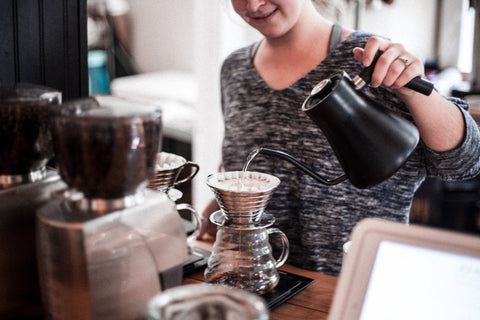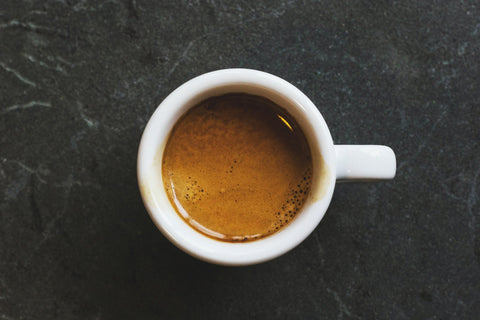Consider:
- Investing in reusable pods or biodegradable or compostable pods.
- What material are your filters made out of?
- How is your coffee grown and sourced?
- What are you doing with your coffee grounds or coffee packaging after brewing?
For pod machines: Invest in reusable pods or reusable filter
There are many reusable pod options available for Keurigs and Nespresso. This is important to consider because the amount of K-Cups thrown into the landfill could wrap around the earth more than 10 times! The regular single-use K-Cups are also not recyclable in its current form, because the pod is made up of four layers of specialized plastic, built to withstand heat and pressure. Consider investing in reusable options for K-Cups and Nespresso pods, or switching to biodegradable or compostable pods from companies like Lavazza, EcoPods, and PurPod100.
.
For drip machines: What material are your filters made out of?
Paper is not the only material you can brew coffee with. There are also reusable metal and cloth filters available to use. Cloth filters are an affordable substitute for paper filters, though they require a little more time and equipment to clean. Metal filters are more expensive, but a good investment that you can reuse over and over again with minimal extra effort for upkeep.
If you still want to use paper filters, you can opt for buying unbleached, brown paper filters, which are filters that do not go through the dyeing process. Just be sure to pre-wet the filter before putting the coffee grounds in the machine to get rid of any papery taste! You can also compost your paper filters after brewing with it. In barista and home brewing circles, some have experimented with reusing a paper filter multiple times -- with positive results in their cups of coffee!
What material is your cup made out of?
Invest in a glass, metal, or ceramic pour over instead of a plastic one. While plastic is a durable and cheaper alternative compared to glass or metal, plastic never biodegrades. Furthermore, high temperature water when brewing coffee into a cheap plastic mug or cup may leach plastic into the coffee - yielding an unhealthy and plastic-tasting cup of coffee. “Plastic” is a flavor note that we definitely don’t want to find in our coffee.
How is your coffee grown and sourced?
Consumers can make better coffee choices to support a more environmentally friendly industry through choosing a sustainably-sourced, high-quality coffee. These choices can have a major impact on the global ecosystem. Conscious shopping looks like checking for certifications like organic and fair trade. Organic certifications indicate that the coffee was grown without the use of synthetic pesticides that might be harmful to the overall environment, and fair trade certifications tell the consumer that farmers were paid a premium over the market price for their coffees.
There are also other labels that coffee consumers can look for on their bags of coffee or on a coffee company’s information. The customer can check if the coffee is shade grown or bought through direct trade. Shade grown coffee is a more sustainable way of growing coffee than methods that maximize farm productivity. Shade-grown coffee methods promote biodiversity, prevent soil erosion through the shade trees extensive root network, provide nutrients from fallen litter, and decrease the amount of carbon in the air through fixation by plant tissues. Direct trade is an indicator that the coffee company works with the coffee farmers themselves to either set premium prices or even collaborate to support the farmers’ community.
What are you doing with your coffee grounds and packaging after brewing?
Dumping coffee in the landfill means that those coffee grounds will produce methane, a harmful greenhouse gas. You can divert your grounds from the landfill through composting or repurposing your coffee grounds. Composting is an easy, environmentally-friendly action you can do with your used coffee grounds. Simply throw your grounds into your compost pile. When composted, the coffee grounds add nitrogen to the soil. You can also add the grounds right into your garden as fertilizer -- it helps with soil drainage, aeration, and water retention.
After brewing, we can look at repurposing our coffee grounds. Some recipes even call for coffee grounds as rubs or pastry flavoring. You can even use coffee grounds to absorb unwanted odors in your fridge or your trash can. You can also use it as a body scrub to exfoliate dead skin from your body or a way to absorb any residue on your scalp or hair. The journey for coffee doesn’t have to stop in your cup or the landfill.
The coffee lifestyle usually comes along with packaging, so we can be diligent in either recycling or composting any coffee bags or packaging that we come across. Check your coffee bags for the recycling symbol. If it does not have any lamination or plastic in it, you can also use it as brown matter for yours or your community garden’s compost pile.
Understanding the process and mechanism of how coffee has been carefully tended by people all across the world, we at Everyday People Coffee and Tea source sustainable, single origin coffees from farmers, ensuring that those farmers are also provided equitable wages to sustain a livelihood that depends on the coffee trade. We are deeply committed to sourcing quality beans to produce our premium coffees. Our coffee is roasted in a registered and approved FDA facility adhering to sustainable practices.
Let us know how your coffee journey is going at our Instagram @everydaypeople_coffee or our contact form!



